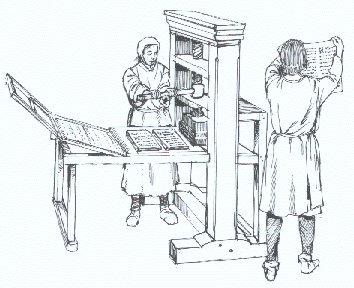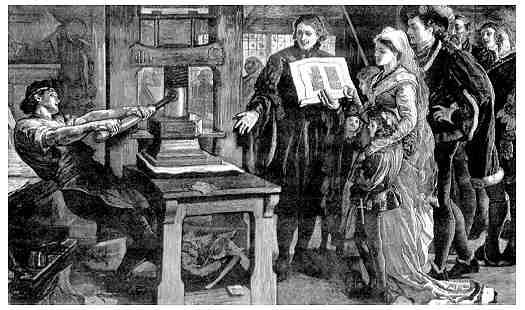One of the reasons
we relocated in early 2003 was so that we could begin plans for
building a period printing press. Here you'll find a few notes
and link with information on period press'. We haven't
been able to pursue this desire so far but I want to keep these
notes about just in case we ever get the chance to make this
dream real.
English Common Press
Printers
Industry
|
 |
|
Click the image to visit MinVent |
Assorted Notes
Taken from
http://neil.franklin.ch/Usenet/rec.org.sca/19971125_Printing_press_period_or_not
-
The two oldest surviving printing presses
are of the 16th century and are to be found in the
Plantijn-Moretus-Museum in Antwerp.
-
The earliest illustration of a printing
press is to be found in a "death's dance" cycle made in Lyon
in the 1490's.
-
Jost Amman's "Stšndebuch" or "Book of
Trades" was first published in 1568. (Dover ISBN
0-486-22886-X) It shows a book printer at his > press.
-
Leonardo da Vinci made some designs for an
improved printing press, though it isn't sure whether they
were ever executed. He focused of the ergonomically and
economical aspects by putting the typecast on an inclined
platform, so that the printer would be enabled to put
another sheet of paper on the type in less time than before.
-
Gutenberg's cast metal types replaced the
plate. They were "mass produced" (one copper tool per letter
needed). This had multiple advantages:
- all letters of the same tape (a, b, c)
look the same. This makes reading easier.
- wood cuts become fuzzy at about 50 copies,
useless at 150..200. Modern wood cut artists number their
copies, price drops above copy 20! Metal types (mainly lead,
but Gutenberg used gold) last 1000+ copies.
- text consists of stringing letters, this
is faster than cutting. Even if you count casting time
(don't forget reuse of types).
- spelling errors can be corrected, simply
replace a type. Try correcting cut wood (make a hole, insert
a peg, cut that).
-
The first image of a screw-type printing
press is dated 1499 - Artist unknown. About 40 pre-1600 A.D.
images exist of these presses, but is apparent that some
images are adaptations of prior images. Print evidence shows
that the basic form of the screw-type press was set and
functional at the beginning of the 16th C. and that there
were few changes until the start of the 17th C. In 1507
Jodicus Badius Ascensius (of Paris) produced a print showing
the model as used throughout the 16th C. this was a wooden
screw driven printing press. In 1511 Albrecht Durer sketched
a printer using the "wooden screw type" printing press. It
is thought that his sketch is of the press used in the
printing office of his godfather Anton Koberger. A print
dated 1520 (artist unknown - cannot find the artist's mark)
shows a fine example of this press with miscellaneous press
tools - bodkin, scissors, paste brushes, and the frisket
frame.
|
 |
|
Antique Print by "The Graphic"
DATE PRINTED: June 30th 1877
The overall size is approx. 22x16 inches.
This is a brief
description with a note of the contents of this
picture: A moment in history where Caxton explains
the machinations of his world changing invention,
the printing press. The King & Queen look very
interested, as the young princes stay close to their
mother. The opposites of their elegant and opulent
dress, compared to Caxton and the press worker, is
quite striking here. The above scanned image does
this print no justice as it has much more detail
than the impression shows. |
Conversations with Printing Press Historian
Steve Pratt:
Book History Workshop Conchobar hopes to attend
this workshop with Steve Pratt in the future.
Additional Bibliography
-
Blumenthal, Joseph.
1973. Art of the Printed Book 1455-1955. New York,
NY: The Pierpont Morgan Library.
-
First Scottish Books http://www.nls.uk/didgitallibrary/chepman/index.html,
accessed December 2002. National Library of Scotland.
-
Jean, Georges. 1992.
Writing: The Story of Alphabets and Scripts. New
York, NY: Harry N. Abrams Inc.
-
White, Jan V. 1988.
Graphic Design for the electronic age. New York,
NY: Watson-Guptill Publications.
|